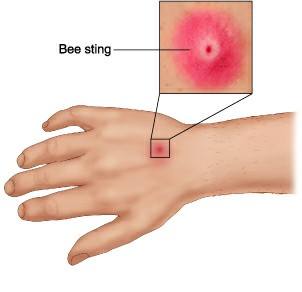Bedbugs are small wingless insects (Cimex lectularius) that come out at night to feed. They live in dry, dark crevices such as the seams of mattresses, furniture, floorboards, wallpaper, and suitcases. Their only food source is blood, and they can live for up to a year without a meal. Their bite is painless, so you will likely not be awoken. They usually feed in the very early morning hours, which explains why they are mostly found in and around your bed. It can take up to 30 minutes for them to complete their meal. In the absence of the bedbug’s preferred human host, it will feed on any warm-blooded mammal.
Bedbugs do not discriminate, so anyone can be affected. Additionally, there is usually no relationship between a bedbug infestation and poor hygiene or an unclean home. They are most commonly found in places where there are a high number of people, such as in hotels, prisons, shelters, apartment buildings, and dorms. They can travel to your home in used furniture or in suitcases.
Bedbug infestations have been on the rise. This is thought to be due to recent increases in international travel along with changes in insect pesticides that do not affect the bedbug but do kill the bedbug’s natural predators, the cockroach and red ant.
Signs and Symptoms
The morning after being bitten the bedbug, you may notice an itchy hive-like bump at the site of the bite mark, which will go away through the course of the day. There may or not may not be a visible bite mark in the center of the bump. After that, what start as small bruise-like areas turn into red, intensely itchy bumps on the exposed parts of the body (arms, legs, chest, and sometimes the face). There may be a clustered configuration of 3 bites in a line (commonly known as “breakfast, lunch, and dinner”). Resolution takes about 2 weeks and leaves some darkening of the skin (post-inflammatory hyperpigmentation).
You may see tell-tale signs of the bedbug’s presence, such as blood stains on the sheets, flecks of bedbug dung on or around your bed, or you may smell a sweet odor that occurs when there is a large bedbug infestation. You may be able to spot a moving bedbug if you are searching at night.
The management of bedbug bites includes removing the bedbug infestation and controlling the itching.
The best time to look for live bedbugs is the middle of the night, when they come out to feed. Wash all linens in hot water and dry in a hot dryer. You may also need to wash your curtains. Scrub furniture to remove eggs, and fix any cracks that may be in the furniture; you may need to take the furniture apart to do this well. Vacuum the room, including the mattress (concentrating on the seams) and any surrounding crevices. You may want to fill and seal any cracks around the room and paste down any rolling wallpaper seams. Check the adjoining rooms for bugs as well, even if the occupants don’t complain of itching.
Sometimes, in cases of severe infestation, it may be best to have a licensed pest control agent inspect and eradicate the bedbugs. Be aware that some insect repellants can be toxic to children, so make sure to find out exactly what chemicals they will be using and what the chemical’s risk profile is.
Diphenhydramine can be used to control the itching. A low-strength topical corticosteroid cream or ointment, such as hydrocortisone, can be purchased over the counter to help with itching.
When you travel and stay in hotels, keep your suitcase and clothing away from the bed or other furniture. Upon returning home, wash the clothing you took with you, and place your suitcase in an attic, basement, or garage, where there is little chance of the bugs encountering humans for prolonged periods at night.
Your doctor may give you an antihistamine, such as Benadryl, and/or topical corticosteroids to help reduce the itching and inflammation.
